Hans Christian Andersen Blu-ray Movie
HomeHans Christian Andersen Blu-ray Movie 
Warner Bros. | 1952 | 112 min | Not rated | Dec 18, 2012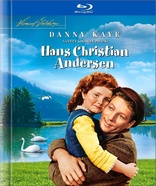
Movie rating
7.3 | / 10 |
Blu-ray rating
| Users | 3.8 | |
| Reviewer | 3.5 | |
| Overall | 3.5 |
Overview
Hans Christian Andersen (1952)
A fantasy/musical re-imagining of the life of the great Danish writer of children's stories. Expelled from his village for distracting the local children from their studies, he travels to Copenhagen, where he falls under the spell of a glamorous opera diva.
Starring: Danny Kaye, Farley Granger, Renée “Zizi” Jeanmaire, Joey Walsh, Philip TongeDirector: Charles Vidor
| Musical | Uncertain |
| Family | Uncertain |
| Comedy | Uncertain |
| Biography | Uncertain |
Specifications
Video
Video codec: MPEG-4 AVC
Video resolution: 1080p
Aspect ratio: 1.37:1
Original aspect ratio: 1.37:1
Audio
English: DTS-HD Master Audio Mono (48kHz, 24-bit)
Subtitles
English SDH, French, Spanish
Discs
25GB Blu-ray Disc
Single disc (1 BD)
Playback
Region A, B (C untested)
Review
Rating summary
| Movie | 3.5 | |
| Video | 3.0 | |
| Audio | 3.5 | |
| Extras | 1.0 | |
| Overall | 3.5 |
Hans Christian Andersen Blu-ray Movie Review
Tall Tales
Reviewed by Michael Reuben January 31, 2013Films rarely come more pedigreed than Hans Christian Andersen. The producer was the legendary Samuel Goldwyn, who labored for years to create a film worthy of the Danish fabulist, commissioning script after script, none of which satisfied him. The writer who finally produced a screenplay that pleased Goldwyn was Pulitzer Prize winner Moss Hart, of the famed Broadway hit-making team of Kaufman and Hart, best known for The Man Who Came to Dinner. The songs were by Frank Loesser, the tunesmith of Guys and Dolls (and later of How to Succeed in Business Without Really Trying). The director, Charles Vidor (not to be confused with "King" Vidor), had helped make Rita Hayworth famous in Cover Girl and Gilda. And the star was funnyman Danny Kaye, who had formerly been under contract to Goldwyn, for whom he'd made such films as The Secret Life of Walter Mitty. Goldwyn was less interested in Andersen the man than in Andersen the storyteller; so Hart's script adopted the clever convention of reimagining Andersen's life as one of his own stories. A disclaimer at the opening of the film warns that none of it is true. This liberated the filmmakers to do whatever they wished. During production, Goldwyn promoted the film by inviting the great CBS newsman Edward R. Murrow behind the scenes for an episode of his "See It Now" program. Long before the era of "electronic press kits", Goldwyn created his own on live TV. (Sadly, no recording seems to have survived.) He also invited photographers from top publications to shoot one of the film's ballet sequences, and he arranged promotional appearances on the TV show hosted by Dinah Shore. The result was a box office smash when Hans Christian Andersen was released for Thanksgiving 1952. The film left such fond memories that, when ABC first showed it on TV in 1966, they decided not to trim it to fit a two-hour time slot, with commercials. Instead, they expanded the time slot by a half hour and had the presentation hosted by Danish musician Victor Borgia. But enough nostalgia. How has the film aged?
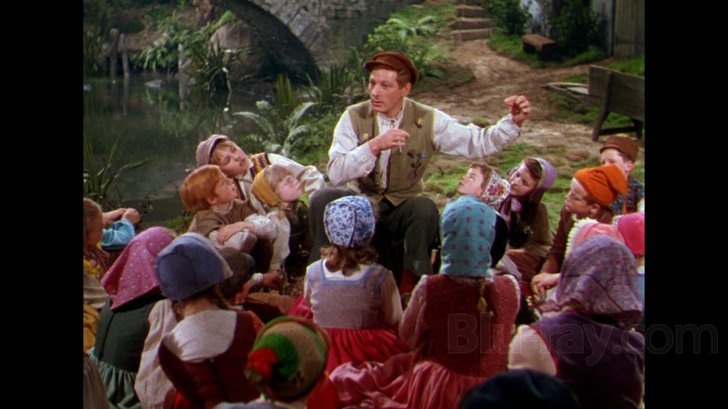
Hans Christian Andersen falls into roughly two parts. The first has retained every bit of its original appeal, especially as a family picture. The second part? Not so much. The first part finds the fictional Hans (Kaye) living the simple life of a shoemaker, or "cobbler", in the small town of Odense in the Danish countryside, where business is slow, just as he likes it. This leaves him plenty of time to beguile the local children with fanciful tales from his fertile imagination, to the consternation of the local schoolmaster (John Brown), who often finds his classroom empty, because the pupils forget the time when Hans is weaving his spell. Hans's apprentice, an orphan named Peter (Joey Walsh), worries equally about the town's reaction and the lack of business, but Hans keeps telling him to relax. They seem to have reversed the roles of child and adult. At the schoolmaster's urging, Hans is banished from the town, but rather than convey the message as ordered, Peter persuades Hans to take the trip to Copenhagen he's always dreamed of. Soon joined by Peter, Hans turns the trip itself into a fabulous adventure. Upon arrival, he and Peter attempt to set up a cobbler's shop in the Great Square, and Hans is immediately arrested for a minor transgression involving the King's statue. Even in a jail cell, he can't help but spin tails. One of the film's loveliest scenes involves Hans improvising the story of Thumbelina to a little girl outside his jail cell window. Peter is able to obtain Hans's release when he overhears that the ballet company performing at the Royal Theater urgently needs a cobbler. Thus begins the film's second half, which is dominated by a love triangle involving Hans, the company's prima ballerina, Doro (Zizi Jeanmaire in a role originally intended for The Red Shoes star Moira Shearer) and Doro's husband Niels (Farley Granger), who is also her tyrannical choreographer. It is for Doro that Hans writes the tale of the little mermaid, which, unlike most of the famous Andersen stories used in the film, is not transformed into a light-hearted Frank Loesser song but into a 17-minute ballet staged by French choreographer Roland Petit. Fans of ballet will be thrilled. Other viewers, including youngsters who may have been enthralled up to this point by Danny Kaye's charming performance as the fictional storyteller, may find their attention wandering. (Mine certainly did.) The second half of Hans Christian Andersen is not without its lively moments. Hans's spontaneous creation of the tale of the ugly duckling to comfort an unpopular boy is a high point, as is the scene in which the boy's father, a newspaper publisher, expresses his gratitude by offering to print Hans's stories, which prompts Hans to reprise the title song ("I'm Hans Christian Andersen!"). But once Hans falls in love with Doro, the film slows to a crawl, and it doesn't fully recover until the very end, when Hans has awakened from his dream of "rescuing" Doro and has safely returned to Odense, now a published author and welcomed back by all the citizens of the village. The fact that Danny Kaye's Hans is so substantially displaced by ballet performances in the latter half of the film is only part of the problem. (Anyone who hasn't seen Hans Christian Andersen since childhood may be surprised to discover just how much Kaye is upstaged, or simply forced off the screen, whenever the ballet company appears.) The marriage of Doro and Niels introduces a discordant note that even so talented a writer as Moss Hart was unable to resolve. At work, the couple are vicious antagonists, sparring, routinely insulting each other, even engaging in what today would be called spousal abuse. But at home, they're a loving couple. While an adult drama can accommodate such multi-faceted relationships, a fairytale needs people to be good or bad, but not both at the same time. No wonder Hans is confused. He sees Doro as a character in one of his stories. He doesn't realize that he's just stepped into the 19th Century Danish version of Who's Afraid of Virginia Woolf?
Hans Christian Andersen Blu-ray Movie, Video Quality 

Two-time Oscar winner Harry Stradling (for My Fair Lady and The Picture of Dorian Gray) shot Hans Christian Andersen. Overall, Warner's 1080p, AVC-encoded Blu-ray reproduces Stradling's lush Technicolor photography effectively. However, fine detail is not as well-resolved as one might expect from a properly preserved 35mm Technicolor source from this era. Morever, in a handful of shots—and they're usually long shots—video noise rears its ugly head. It has been suggested that these flaws are the result of irremediable defects in the existing source materials, since Warner's current digital processes for reproducing, and addressing problems with, three-strip Technicolor preservation elements are known to be first-rate. However, no one outside the technical crew really knows what the cause is. We can only report what we see. For the most part, the Blu-ray image is sufficiently detailed and vividly colorful that these issues amount to a minor distraction. (Note that video noise is frequently hard to spot on screen captures. It only fully reveals itself in motion.) The film's grain pattern appears undisturbed by filtering or other inappropriate manipulation. Although Hans Christian Andersen runs almost two hours, the only disc-based extra is a trailer, and there is only one audio track. A BD-25 accommodates the film without challenging the compressionist, and no compression artifacts were observed.
Hans Christian Andersen Blu-ray Movie, Audio Quality 
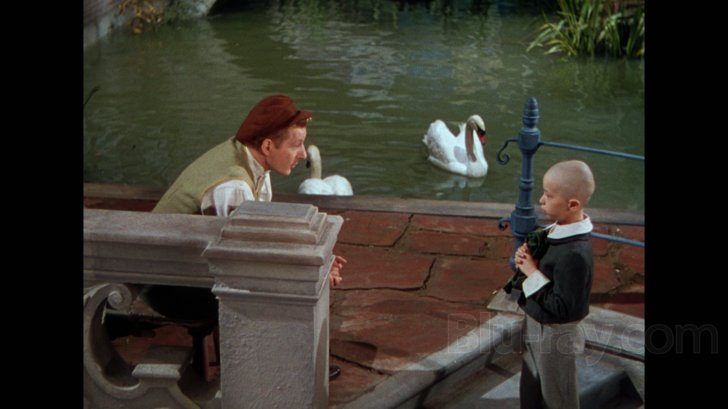
The film's original mono track is presented in lossless DTS-HD MA 1.0, and it sounds quite good for its age. Voices are clear enough, whether speaking or singing, and while the orchestra may lack the range it might have with a contemporary stereo or 5.1 recording, it certainly has enough presence to convey the grandeur of the titular storyteller's imagination and the grace of the ballet dancers' disciplined moves. Warner should be congratulated for leaving well enough alone and providing the film's original mix, without any attempt to pull it apart electronically and repurpose it for modern home theater systems. Those mixes almost always end up sounding artificial, whereas this one sounds like it belongs with the film.
Hans Christian Andersen Blu-ray Movie, Special Features and Extras 
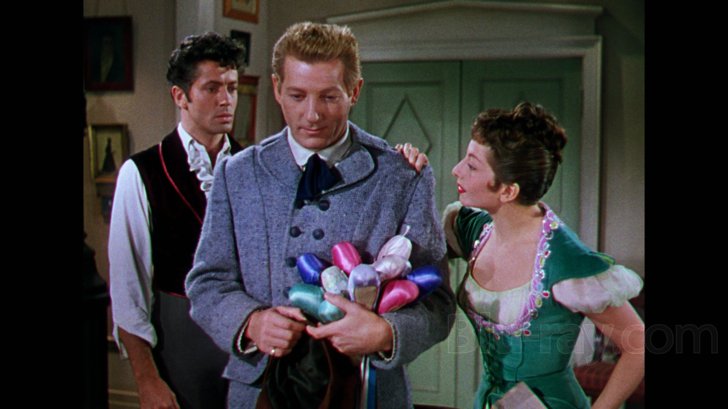
- Theatrical Trailer (480i; 1.33:1; 2:43): When was the last time you heard a producer's name mentioned so many times in a trailer's voicover?
- DigiBook: Warner has packaged Hans Christian Andersen in an attractive digibook illustrated with production photos, lobby cards, one sheets and drawings. The text provides an overview of the production's lengthy development, as well as biographies of Samuel Goldwyn, Danny Kaye, Renée "Zizi" Jeanmaire, Farley Granger, Roland Petit, Frank Loesser, Moss Hart, Charles Vidor and Hans Christian Andersen.
Hans Christian Andersen Blu-ray Movie, Overall Score and Recommendation 
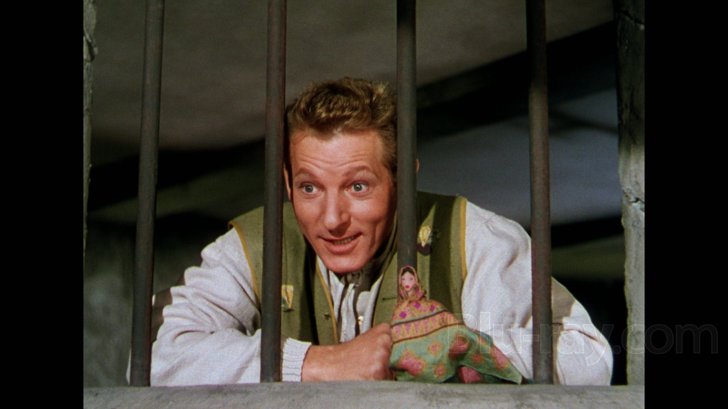
One of the many reasons why Hans Christian Andersen is so fondly remembered is the separate record album released to coincide with the film, on which Danny Kaye re-recorded the Frank Loesser score. More people probably know the songs from that album than from the film. The album is currently out of print, although it is available on various import CDs, but the songs sound quite good on Warner's Blu-ray. Much of the film that surrounds them is also worth seeing. Just be prepared to use the fast forward button. Recommended, with appropriate caveats.
Other editions
Hans Christian Andersen: Other Editions
Similar titles
Similar titles you might also like

A Christmas Story Live!
2017

Thoroughly Modern Millie
1967

Jack and the Beanstalk
Archive Collection
1952

The Court Jester
Paramount Presents #13
1955

Anchors Aweigh
1945

Gypsy
Warner Archive Collection
1962

Du Barry Was a Lady
Warner Archive Collection
1943

That's Entertainment, Part 2
1976

That's Entertainment III
1994

Company
Stephen Sondheim's Company
2007

That's Entertainment
50th Anniversary Remastered Edition | Warner Archive Collection
1974

Bye Bye Birdie
1963

Bugsy Malone
Paramount Presents #23
1976

Ziegfeld Follies
Warner Archive Collection
1945

Mame
1974

Victor/Victoria: The Broadway Musical
1995

Deep In My Heart
Warner Archive Collection
1954

Bathing Beauty
Warner Archive Collection
1944

Les Girls
Warner Archive Collection
1957

How to Succeed in Business Without Really Trying
1967
